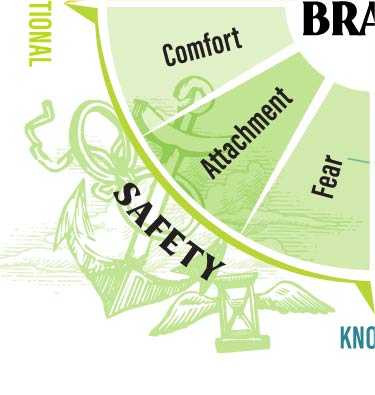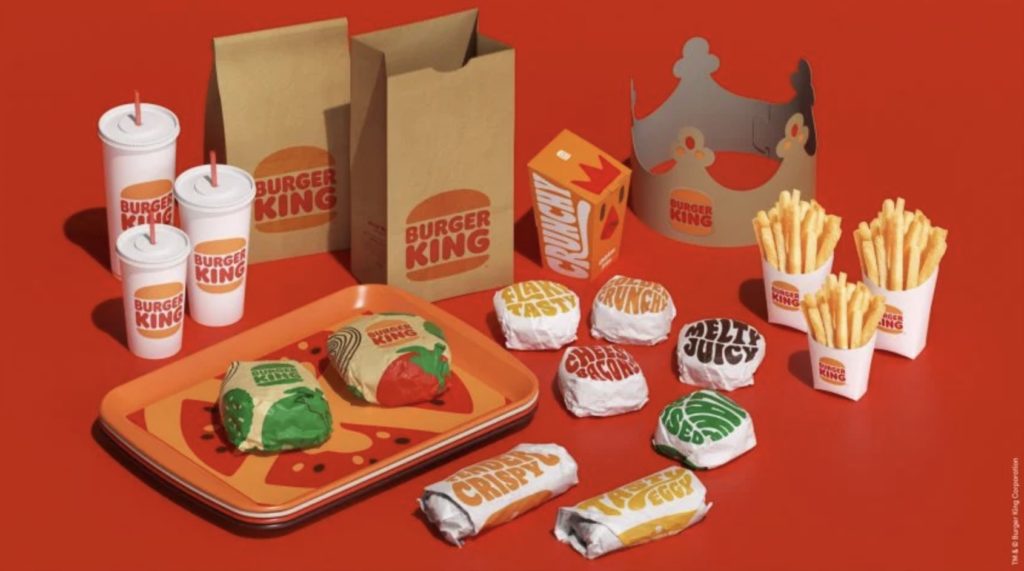
Brands provoke us. They make us feel excited, inspired, powerful, and hopeful. Brands work across the whole spectrum of emotions to engineer our reactions. They get us to engage, believe and return for more.
For the past few months at Flux, we’ve been exploring the Brand Feel Wheel. It’s a branding strategy framework we crafted that explains how brands use strategic emotional triggers to craft memorable communications.
You see, when brands make us feel, brand interaction is elevated from a simple transaction to an experience.
We use it to guide our brand strategies.
This month, we’re looking at the quadrant of brands that make us feel safe. In a world filled with uncertainty, Safety Brands are in high demand. So, what are Safety Brands and how do they use emotional motivators to make us act?

Safety: the condition of being protected from or unlikely to cause danger, risk, or injury.
Safety brands give a sense of protection, stability, and trust. They’re recognizable and authoritative, playing on history, memory, nostalgia, and shared cultural understandings. With safety brands, we’re firmly in our comfort zones.
On the Brand Feel Wheel, the Safety Quadrant exists on the Known+Traditional side of the Perception Axes.
Brands in this quadrant provide a known experience with a traditional position.
• Safety Brands provide classic offerings to established markets. They’re not doing anything new– their strength comes from the fact that they are clear, constant, and recognizable.
• Safety Brands protect us from harm. They implicitly or explicitly present a loss, danger, or risk that they help us avoid. They also provide a way for us to access a previous state of insulated safety, like bringing us back to childhood or reminding us of simpler times.
• These brands earn our trust by building authority. They can do this by referring to an established history and/or crafting a reputation for consistently high quality.
Because they combine the known with the traditional, Safety Brands often become heritage brands.
• Heritage brands fall into two categories. They can be legacy companies, which are supported by a long history of establishment and are firmly rooted in the cultural consciousness. They can also be newer companies that play on a historical aesthetic to spark nostalgia and build authority based on an idealized past.
• High-end luxury brands are usually heritage brands. Think Chanel, Porsche, and Rolex. They’re universally known, synonymous with their commitment to craft and quality. You get exactly what you expect– a top-quality product from the master makers in their sector. We pay a high price to be assured we’re getting something timeless. Their offering is classic, known, and constant, and the brand experience echoes that.
• Brands that play on nostalgia make us feel safe in an ever-shifting present. Comfort food brands are a perfect example, like Hershey’s and Campbell’s Soup. These brands have kept their look and feel constant since their founding, providing a sense of constancy that’s expected, understood, and comforting.
Motivators and Positioning for Safety Brands

Safety Brands play on our desire for consistency and clarity. They help make us feel secure and protected in a world that’s ambiguous, dangerous, and constantly changing.
They do this by tapping into three main emotional motivators: comfort, attachment, and fear.
Successful Safety Brands correlate their product or service with achieving the desired feeling, providing an emotional incentive that proves much more powerful and memorable than the offering alone. Let’s look at three examples of campaigns created by Safety Brands that play on these powerful emotions.
1. Comfort
What it is: A state of physical ease and freedom from pain or constraint.
Why brands use it: Comfort is a universally positive and desired emotion. We’re exposed to a lot of frustration and discomfort in our daily lives– sitting in traffic, standing in the rain. We crave brands that make us feel at ease, and will quickly form a habitual connection with them.
How to tap into it: Brands comfort us by transporting us to a moment of safety and relaxation. They often play on nostalgia, bringing us into a world that reminds us of happier times, simplicity, childhood, and home.
Branding Example: Comfort

Brand: Burger King
Campaign: 2021 Rebrand
Burger King has unveiled their first brand update in more than 20 years, with a new logo, packaging, and employee uniforms. The new logo harkens back to their 1970s logo, with slightly updated typography. The flat warm colors, retro illustrations, and groovy lettering are total 70s nostalgia.
It feels happy, welcoming, and easy, transporting us back to an idealized past when things were simpler. It’s comfort food with a comfortable look to match.
2. Attachment
What it is: Affection, fondness, or sympathy for someone or something.
Why brands use it: When brands forge a bond, it’s a lasting impression that turns customers into lifelong loyalists. When we feel attached, the brand ceases to be solely a company with offerings. It becomes part of us.
How to tap into it: Brands inspire attachment by fundamentally connecting their offering with an emotional moment or experience. They act as a time capsule through which the memory lives on into the future, creating a lasting attachment.
Branding Example: Attachment

Brand: De Beers
Campaign: A Diamond Is Forever
One of the most famous slogans of all time, this concept essentially invented the diamond engagement ring when it was written in 1947.
“Over a billion years old, a diamond is one of the closest things to Forever that we can hold in our hands,” reads the De Beers website. “In a world of short-term fixes where so much is disposable, symbols of enduring strength are more important than ever.”
De Beers imbued the diamond with the ability to capture moments of emotional intensity. You can’t relive the proposal, but you’re brought back to it every time you look at your diamond ring. The moment is fleeting– but the diamond is forever.
3. Fear
What it is: An unpleasant emotion caused by the threat of danger, pain, or harm.
Why brands use it: Fear is an incredibly powerful motivator. It plays on one of our base emotions, triggering instinctual action. While it can’t work for all offerings and sectors, when done right fear can mobilize a highly vocal audience that’s willing to spread the message.
How to tap into it: Because it’s a negative emotion, brands have to be very careful when using fear-based messaging. It’s important to present the risk and then clearly associate how your offering helps avoid this loss or danger.
Branding Example: Fear

Brand: Volvo
Campaign: The Ultimate Safety Test
Volvo is one of the safest car manufacturers on the market. Safety has long been a central part of their brand, focusing on how Volvo technology will protect passengers from fatal injuries in a car crash. Their 2021 campaign, “The Real Safety Test,” takes this even further.
After the spokesperson examines a series of traditional Volvo crash tests, he wonders what is the ultimate test for safety. The camera cuts to the Arctic ice shelf crumbling into the ocean.
Global warming puts all humankind at risk, and Volvo’s ad effectively stirs up that fear. But they also show what they’re doing to mitigate the threat, pledging to be fully electric by 2030.
How to Position your Own Safety Brand


Safety Brands, Spirit Brands, Imagination Brands, and Adventure Brands are the primary quadrants of the Brand Feel Wheel. Brands use different emotional triggers to inspire a sense of spirit, adventure, or imagination.
After working with hundreds of clients at our branding agency in Los Angeles, we’ve created a graphic representation of how brands use emotions to make their way into our hearts and minds.
We call it the Brand Feel Wheel.
Locating brands on the wheel allows us to take a deep look at how today’s most influential companies are shaping our consciousness. The most influential brands are able to communicate more than the goods they’re selling. They’re offering us something far less tangible and yet much more powerful: a feeling. They play into our base human desires, influencing our every move.
All brands have the potential to resonate on this deeper level.
But it requires a clear understanding of who you are, what you believe, and what you represent. Locating your brand on the Feel Wheel helps you draw out these big ideas, providing a rich set of emotions that can be used to inspire loyalty, action, and memorability.
Do you need help finding your place on the Brand Feel Wheel? Contact us and let us help you solidify your brand’s positioning.